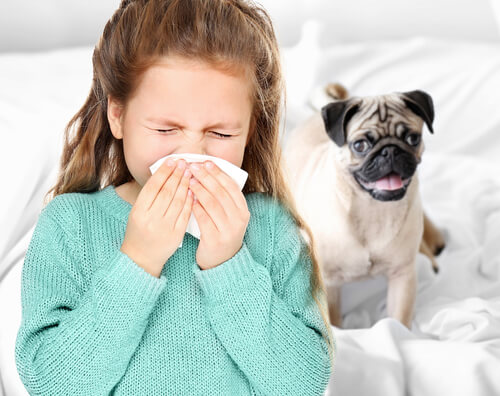Hypoallergenic Dogs: Myth or Reality?


Written and verified by the lawyer Francisco María García
Experts claim that there are no hypoallergenic dogs. There are dogs that can make us happy and others that don’t. The cause of our displeasure can be the dander that the fur gives off and as well as their saliva. Because of that, people seek out hypoallergenic dogs as pets.
Therefore, any breed of dog can cause allergies. Even though some dogs tend to have less fur, substances that adhere to their fur get into the environment. As a result, this will cause an allergic reaction in those who suffer from them. This is not related to the breed of the dog. Hypoallergenic dogs may not exist, however there certain actions that you can take to lessen the causes of allergies.
What can we do about dog allergies?
In order to minimize the factors that cause allergies from dogs, there are specific products that can be applied to the fur. These prevent the dander from coming off the animal and easily spreading into the environment. Also, it’s good to know that there have been no known cases where dogs have produced allergic reactions among themselves.
When the dog is already in the house and one of the family members discovers he or she is allergic, there are vaccines available to treat the allergy. However, they’re only used under certain circumstances. It depends upon the type of animal, the patient’s symptoms, and other associated illnesses.

Hypoallergenic dogs and their size
Some specialists have claimed that there are no breeds of cats or dogs that cause allergies in various degrees. At the same time, it’s possible that the degree of allergic reaction is less. For example, when a dog is small the amount of dander that it disperses is also small.
Tests show that cats and sterilized male dogs also produce less epithelium (dander). As a result, they produce less allergic reactions and they may be considered somewhat hypoallergenic animals.
There was an evaluation of canine breeds: Bedlington Terrier, Yorkshire Terrier, French Poodle, Schnauzer and the Xoloitzcuintli.
When it comes to cats, the following cause fewer allergies: Sphynx or Esfinge, Devon Rex, Cornish Rex, Siberian or Russian Blue.
Nevertheless, the fact that these breeds or smaller dogs may cause less of a reaction doesn’t mean that those allergic will be free of a reaction. This is especially true when a person is extremely allergic. In that case, if the person is very affected, it’s best not to have a dog in the home.

Tips to fight allergies in the home
Once the pet is in the home and there are allergic symptoms, there are things that you can do, such as the following:
- Frequently bathe your pet to avoid the effect of the fur.
- Avoid allowing the recently arrived animal in the bedrooms. With the pet, go through the rules of living in the home. This includes, where you allow him to go and where he’s not welcome.
- Brush your pet regularly and if possible outside the house.
- It’s very helpful to use air purifiers with a filter, both with air conditioning and heat, etc.
- Avoid using fabrics and clothing the can easily absorb allergic elements. This includes carpets, rugs and wall hanging made of fabric, such as tapestries.
- Use the many commercial products that reduce dirt, pollen, and dust. Apply these directly on your pet.
- Also, there are many steam cleaning systems that eliminate the particles in the air.
- There are tests that experts run which will determine the origin of the allergy.
- When an allergy is diagnosed, it’s not recommended that the pet is in the house one hundred percent of the time. In these cases, a consultation with a physician will help determine the situation and the precautions that may need to be taken.
- In addition, a veterinarian who is a specialist can give advice. We can find out what products are available on the market that will help lessen the effects of the dander, along with other important measures that can be taken.
So, now you can decide if there really are hypoallergenic dogs!
Experts claim that there are no hypoallergenic dogs. There are dogs that can make us happy and others that don’t. The cause of our displeasure can be the dander that the fur gives off and as well as their saliva. Because of that, people seek out hypoallergenic dogs as pets.
Therefore, any breed of dog can cause allergies. Even though some dogs tend to have less fur, substances that adhere to their fur get into the environment. As a result, this will cause an allergic reaction in those who suffer from them. This is not related to the breed of the dog. Hypoallergenic dogs may not exist, however there certain actions that you can take to lessen the causes of allergies.
What can we do about dog allergies?
In order to minimize the factors that cause allergies from dogs, there are specific products that can be applied to the fur. These prevent the dander from coming off the animal and easily spreading into the environment. Also, it’s good to know that there have been no known cases where dogs have produced allergic reactions among themselves.
When the dog is already in the house and one of the family members discovers he or she is allergic, there are vaccines available to treat the allergy. However, they’re only used under certain circumstances. It depends upon the type of animal, the patient’s symptoms, and other associated illnesses.

Hypoallergenic dogs and their size
Some specialists have claimed that there are no breeds of cats or dogs that cause allergies in various degrees. At the same time, it’s possible that the degree of allergic reaction is less. For example, when a dog is small the amount of dander that it disperses is also small.
Tests show that cats and sterilized male dogs also produce less epithelium (dander). As a result, they produce less allergic reactions and they may be considered somewhat hypoallergenic animals.
There was an evaluation of canine breeds: Bedlington Terrier, Yorkshire Terrier, French Poodle, Schnauzer and the Xoloitzcuintli.
When it comes to cats, the following cause fewer allergies: Sphynx or Esfinge, Devon Rex, Cornish Rex, Siberian or Russian Blue.
Nevertheless, the fact that these breeds or smaller dogs may cause less of a reaction doesn’t mean that those allergic will be free of a reaction. This is especially true when a person is extremely allergic. In that case, if the person is very affected, it’s best not to have a dog in the home.

Tips to fight allergies in the home
Once the pet is in the home and there are allergic symptoms, there are things that you can do, such as the following:
- Frequently bathe your pet to avoid the effect of the fur.
- Avoid allowing the recently arrived animal in the bedrooms. With the pet, go through the rules of living in the home. This includes, where you allow him to go and where he’s not welcome.
- Brush your pet regularly and if possible outside the house.
- It’s very helpful to use air purifiers with a filter, both with air conditioning and heat, etc.
- Avoid using fabrics and clothing the can easily absorb allergic elements. This includes carpets, rugs and wall hanging made of fabric, such as tapestries.
- Use the many commercial products that reduce dirt, pollen, and dust. Apply these directly on your pet.
- Also, there are many steam cleaning systems that eliminate the particles in the air.
- There are tests that experts run which will determine the origin of the allergy.
- When an allergy is diagnosed, it’s not recommended that the pet is in the house one hundred percent of the time. In these cases, a consultation with a physician will help determine the situation and the precautions that may need to be taken.
- In addition, a veterinarian who is a specialist can give advice. We can find out what products are available on the market that will help lessen the effects of the dander, along with other important measures that can be taken.
So, now you can decide if there really are hypoallergenic dogs!
All cited sources were thoroughly reviewed by our team to ensure their quality, reliability, currency, and validity. The bibliography of this article was considered reliable and of academic or scientific accuracy.
A.R.R., H. (2008). Prevention and diagnostic of allergic airways diseases due to dog allergens. Allergologie, 31(10), 422–428. Retrieved from http://www.embase.com/search/results?subaction=viewrecord&from=export&id=L352629653
Hölscher, B., Frye, C., Wichmann, H. E., & Heinrich, J. (2002). Exposure to pets and allergies in children. Pediatric Allergy and Immunology, 13(5), 334–341. https://doi.org/10.1034/j.1399-3038.2002.02063.x
This text is provided for informational purposes only and does not replace consultation with a professional. If in doubt, consult your specialist.








